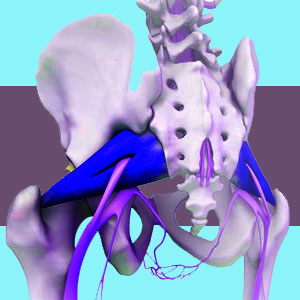
Are you looking for a simple piriformis syndrome definition? We provide all the details you need to fully understand the diagnosis. In fact, this entire website, Piriformis-Pain.Com focuses exclusively on piriformis syndrome and provides the most comprehensive view of the condition on the web today. If you really want to learn just the basics, then this article will surely suffice. However, if you want to become a real expert on piriformis pain syndromes, then we provide all the information you could ever hope to find on this growing health crisis.
The general population usually has no idea what the piriformis muscle is, where it is located or what it does. The muscle is not usually the focus of any attention, until it becomes painful and problematic. Once this happens, being diagnosed with piriformis syndrome can be a shock to patients who have no background knowledge of the muscle or its function. The vast majority of patients have no idea why they have pain nor how to fix the problem, making them perfect targets for exploitation by greedy caregivers who might lead them down the wrong path to effective therapy.
Knowledge is power when it comes to health, while ignorance is weakness. Being ignorant of the piriformis muscle can be a terrible mistake for people who are suffering from pain caused by this vital muscular tissue. The goal of this background dialog is to provide a thorough, but simple look at piriformis syndrome to assist patients in better understanding their diagnosis.
Piriformis Syndrome Definition – Anatomy Background
The piriformis muscle is located in the deep anatomy of the buttocks, near the hip joint. The muscle is part of a grouping of tissues called the lateral rotator group, which is responsible for specific types of movement of the hip and leg.
The sciatic nerve runs in close proximity to the piriformis muscle. In most people, the nerve, which is the largest in the body, runs beneath the piriformis muscle, although in a significant percentage of the population (about 20%) some structural irregularity exists. Some of the possible variations include cases where the sciatic nerve divides around the piriformis muscle, runs in front of the muscle or actually runs straight through the muscle.
The pudendal nerve also exists in the region of the piriformis muscle and can also occasionally demonstrate some abnormality of proximity to the muscle.
Piriformis Syndrome Explained
Now that you know the basic facts of the structures that are involved in piriformis syndrome, we can examine why the pain actually occurs. Piriformis syndrome describes compression of the sciatic nerve and/or pudendal nerves by the piriformis muscle. Most of the time, these nerves can function just fine, even when they run directly through the substance of the muscle. However, in other cases, pain might be present indicating some pathological process that is causing the piriformis to clamp down on the nerve(s), enacting symptoms that mimic sciatica.
Sciatica is not a diagnosis, unlike the common concept of it. Sciatica is a set of symptoms that result due to structural compression of the spinal nerve roots that form the sciatic nerve. In the case of piriformis-enacted sciatica, the symptoms are actually known as pseudo-sciatica, since they are not caused by nerve root compression, but instead originate from compression of the fully formed sciatic nerve via the piriformis muscle.
The piriformis muscle can spasm due to many reasons, causing it to compress these nerve tissues. Abnormalities in the anatomical placement of the nerve will increase the chances for developing piriformis syndrome, but only by a small margin. Injury to the piriformis or imbalances between the piriformis and its antagonistic muscular pairings might cause spasms in the muscle. Finally, regional oxygen deprivation might affect the piriformis muscle, causing it to spasm chronically. All of these factors can cause or contribute to piriformis syndrome.
Piriformis Syndrome Definition and Treatment
The effectiveness of treatment for piriformis syndrome relies completely on the accuracy of why the compression is occurring. There are many reasons why a person might suffer identical sciatica and pseudo-sciatica pain syndromes. Piriformis syndrome is just one of several possibilities.
In many instances, the piriformis is blamed for causing the pain when it is actually innocent or when the compression is just a consequence of some other underlying process. We see both of these circumstances ruin the chances for many patients to find relief. Therefore, it is really, really important that patients who have been suspected of suffering from piriformis syndrome to truly understand the condition in order to improve their chances for accurate diagnosis and therefore, successful treatment. Playing a passive role and allowing some care provider to make all your choices for you is surely the best way to fail miserably when it comes to finding relief…
Injury and imbalance can virtually always be completely resolved using conservative care without the need of drugs, injections or surgery. In fact, statistics clearly show that when conservative care fails, more dramatic methods will usually not succeed either, with misdiagnosis being the most logical reason why this occurs.
When ischemia is the reason for piriformis spasm, the treatment protocol is completely different, since this form of oxygen deprivation is the result of the mindbody processes and should be treated psychoemotionally with knowledge therapy. Treating the muscle itself with any physical modality is bound to provide poor results. However, since knowledge therapy is very effective, safe and basically free to implement, most patients who are aware of the method can utilize it successfully and be free from the pain forever.
[contentblock id=12]
Piriformis Pain > What is Piriformis Syndrome? > Piriformis Syndrome Definition





